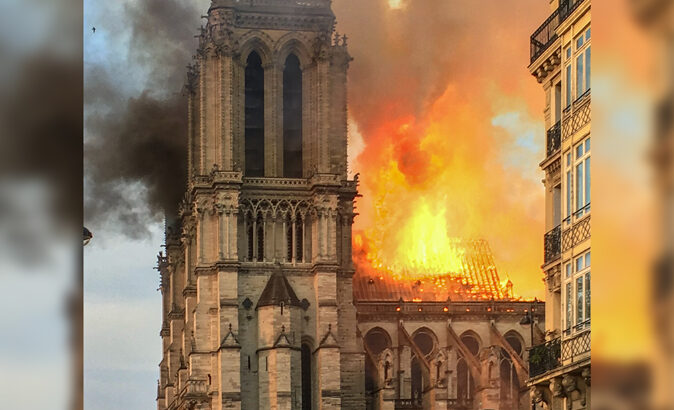A Short History of Notre Dame
by Ken Follett (Pan Books, £12.99 / €14.99)
On April 15, 2019 a fire in the roof space of Notre Dame de Paris appalled those who admire Paris and love the Cathedral. That great medieval edifice, begun in the 12th century, is a dominant symbol of the history and culture of France – as Victor Hugo the Romantic poet realised so long ago.
The wood of the roof was burned out, but the stone vaulting of the inner cathedral ceiling saved the scorching debris from falling into the nave.
The French government vowed to restore it, and the work was soon put in hand and it is now nearing completion.
Paris at present is preparing for the start of the Olympic Games at the end of July. But beforehand the attention of the world is focussed on the preparations in Paris and France in general. This has brought attention to the work on the Cathedral, which is substantially complete. When the Games start the world press will have time and space for little else. So the work on the Cathedral is getting a share of the pre-games attention.
Memories
For my wife and myself who were regular visitors to Paris over many decades Notre Dame has a special place in our memories. I can recall being at Sunday Mass there back in time, sitting in the chairs reserved for worshippers, sitting in a congregation of wealthy Parisian Catholics – the refined height of French respectability.
While we prayed, a party of Japanese tourists passed in front of us, their camera clicking away – those were the days before mobile phones. It was a strange experience. I could imagine Oriental albums later holding pictures captioned: “Native Europeans as at their ritual ceremonies” or some such phrase.
Tourism does strange things to the world. To be classed as a “natives” was probably good for our souls.
The popular book under review was written by best-selling novelist Ken Follett immediately after the fire. His aim was to construe in some way through his own work to the restoration fund, which while largely made up of state funds also appealed for public support from all those people of goodwill whoever they are, who love the Cathedral.
She said she would donate the publisher’s profits to the rebuilding fund and, if I wished, I could do the same with my royalties ‘Yes,’ I said. ‘Of course, I’d love to’”
Aimed at the readers of his “Kingsbridge” series of novels, especially the first written in the series The Pillars of the Earth (1989) set in 1135, focussed on the building of a medieval cathedral in Norman England. A world-wide best seller that novel sold well everywhere, but was some six years on the German bestseller lists – yes six years. In all his books have sold over 188 million copies.
“Two days after Notre Dame burned, ‘Ken Follett has revealed,’ I flew to Paris to appear on the TV programme ‘La Grande Librairie’ for a discussion about cathedrals. The following morning I had breakfast at the Hotel Bristol with my French publisher, and she asked me to write a short book about Notre Dame and what it means to all of us. She said she would donate the publisher’s profits to the rebuilding fund and, if I wished, I could do the same with my royalties. ‘Yes,’ I said. ‘Of course, I’d love to.’”
If even half his global readership were to buy this little book, a genuine work of love, it would amount to a very big donation to the funds for restoration. Follett, like so many people, claims to be a sort of “atheist”, but also a man of spirituality. But he loves nothing betters that a Church service with great music.
Behoves
If Ken Follett can be so generous it behoves Catholics of faith globally to answer in kind.
With all his skills of research, grasp of the period, easy popular expression, this little book is an ideal introduction to the mysterious world of the medieval cathedral builders, a world which is still being explored. And an ideal introduction to the subject, but only an introduction.
For those seeking something more scholarly but still approachable, a book to try would The Cathedral Builders of the Middle Ages, by Alain Erlande-Brandeburg (New Horizons / Thames & Hudson, €7.95).
This is a short book, but filled with extraordinary images which also remind us that the cathedrals were also hand-made in a very special and literal way by masons, architects, and artists”
This is also available in French from Gallimard the original publishers, under the most expressive title of Quand les cathédrales étaient peintes (When the cathedrals were painted”) which in itself captures an aspect of medieval architecture than few reflect upon, the blazing divine glory of the cathedrals inside and out when they were, indeed, painted.
Extraordinary
This is a short book, but filled with extraordinary images which also remind us that the cathedrals were also hand-made in a very special and literal way by masons, architects, and artists of the age and, of course, an ambitious bishop or two.
What those who love the cathedral are looking forward to reading is the report of all that has been learned through the restoration about how the medieval edifice was constructed. But that may take a little time yet. It will be an important work when it appears.
Whatever about the Olympics, which can take care of themselves, anyone going to Paris in the next few months should keep an eye open for more news in the coming months about the restoration of Notre Dame de Paris, truly “Our Lady of Paris”.


 Peter Costello
Peter Costello
